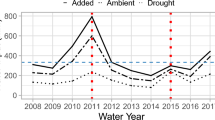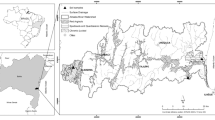Abstract—
Crop abandonment is a factor responsible for soil degradation in semi-arid regions. The effects of crop abandonment on soil restoration may depend on soil properties and climatic conditions of an area. In particular, soil hydraulic properties affect the vegetation recovery process. The objective of this study was to investigate the succession changes in water flow as a result of changes in soil hydraulic properties after crop abandonment under drought and non-drought conditions, and under water uptake by co-occurring perennial plants to clarify the observation that typical perennial grass species are seldom observed in abandoned fields. Soil hydraulic properties were measured in croplands which had been abandoned for different periods (2, 9, and 18 years ago) and in a grazed grassland site (control site). Hydrological processes in the soil profiles were simulated with soil hydraulic properties under drought and non-drought summer conditions with water uptake from perennial grass species. Suctioning the surface soils increased with the period of abandonment, with this trend being particularly obvious in a drought year. Soil water appears to be restricted in the later succession stage of abandoned fields and in grazed grassland for drought-tolerant plants. Dry soil and climate conditions are important factors determining the intrusion of the typical perennial grass, Stipa krylovii, into degraded abandoned fields. A water availability with low pressure (plant can use with low pressure) made difficult the intrusion of typical perennial grasses to abandoned cropland. This abiotic relation between soil hydraulic properties and climate conditions may play an important role for plant succession in abandoned cropland.








Similar content being viewed by others
REFERENCES
L. R. Ahuja, F. Fiedler, G. H. Dunn, J. G. Benjamin, and A. Garrison, “Changes in soil water retention curves due to tillage and natural reconsolidation,” Soil Sci. Soc. Am. J. 62, 1228–1233 (1998).
O. Bazhenova, D. Kobylkin, and E. Tyumentseva, “Aeolian material migration in Transbaikalia (Asian Russia),” Geosciences 9, 41 (2019).
A. Bonet and J. Pausas, “Species richness and cover along a 60-year chronosequence in old-fields of southeastern Spain,” Plant Ecol. 174, 257–270 (2004).
R. A. Bowman, J. D. Reeder, and R. W. Lober, “Changes in soil properties in a central plains rangeland soil after 3, 20, and 60 years of cultivation,” Soil Sci. 150, 851–857 (1990).
G. Campbell, Soil Physics with BASIC, Vol. 14: Transport Models for Soil-Plant Systems (Elsevier, Amsterdam, 1985)
S. Chen, Y. Bai, L. Zhang, and X. Han, “Comparing physiological responses of two dominant grass species to nitrogen addition in **lin River basin of China,” Environ. Exp. Bot. 53, 65–75 (2005).
World Reference Base for Soil Resources (Food and Agriculture Organization, Rome, 1998)
R. A. Feddes, P. J. Kowalik, and H. Zaradny, Simulation of Field Water Use and Crop Yield (Wiley, New York, 1978)
H. Fujimaki and M. Inoue, “Reevaluation of the multistep outflow method for determining unsaturated hydraulic conductivity,” Vadose Zone J. 2, 409–415 (2003).
H. Fujimaki, S. Shiozawa, and M. Inoue, “Effect of salty crust on soil albedo,” Agric. For. Meteorol. 118, 125–135 (2003).
H. Fujimaki and A. Yanagawa, “Application of evaporation method using two tensiometers for determining unsaturated hydraulic conductivity beyond tensiometric range,” Eurasian Soil Sci. 52, 405–413 (2019). https://doi.org/10.1134/S1064229319040069
G. W. Gee and J. W. Bauder, “Particle-size analysis,” in Methods of Soil Analysis, Part 1: Physical and Mineralogical Methods, Ed. by A. Klute (American Society of Agronomy, Madison, WI, 1986), pp. 383–411.
P. D. Gunin, E. A. Vostokova, N. I. Dorofeyuk, P. E. Tarasov, and C. C. Black, Vegetation Dynamics of Mongolia (Springer-Verlag, New York, 2013),
W. Hilbig, The Vegetation of Mongolia (SPB Academic, Amsterdam, 1995),
D. Hillel, Environmental Soil Physics (Academic, London, 1998),
R. Hobbs and J. Harris, “Restoration ecology: repairing the Earth’s ecosystems in the new millennium,” Restor. Ecol. 9, 239–246 (2001).
A. Hoshino, MSc Thesis in Agricultural Science (University of Tsukuba, Tsukuba, 2006).
A. Hoshino, K. Tamura, H. Fujimaki, M. Asano, K. Ose, and T. Higashi, “Effects of crop abandonment and grazing exclusion on available soil water and other soil properties in a semi-arid Mongolian grassland,” Soil Tillage Res. 105, 228–235 (2009).
A. Hoshino, Y. Yoshihara, T. Okuro, J. Undarmaa, and K. Takeuchi, “Effects of vegetation gap on subsequent species richness and cover on abandoned cropland in semi-arid grasslands of Mongolia,” Sand Dune Res. 56, 29–38 (2009).
Q. Hou, Y. Wang, Z. Yang, and G. Shi, “Dynamic simulation and definition of crop coefficient for typical steppe in Inner Mongolia, China,” Chin. J. Plant Ecol. 34, 1414–1423 (2010).
C. Kosmas, S. Gerontidis, and M. Marathianou, “The effect of land use change on soils and vegetation over various lithological formations on Lesvos (Greece),” Catena 40, 51–68 (2000).
N. Lancaster and A. Baas, “Influence of vegetation cover on sand transport by wind: field studies at Owens Lake, California,” Earth Surf. Process. Landforms 23, 69–82 (1998).
Y. Y. Li and M. A. Shao, “Change of soil physical properties under long-term natural vegetation restoration in the Loess Plateau of China,” J. Arid Environ. 64, 77–96 (2006).
L. Y. Liu, X. Y. Li, P. J. Shi, S. Y. Gao, J. H. Wang, W. Q. Ta, Y. Song, M. X. Liu, Z. Wang, and B. L. **a, “Wind erodibility of major soils in the farming-pastoral ecotone of China,” J. Arid Environ. 68, 611–623 (2007).
Y. Matsuura and D. Matsushima, Estimation of evapotranspiration and land-cover with satellite data in semi-arid Mongolia, 2004. https://www.ied.tsukuba.ac.jp/ ~raise/IWSTCM2004/16-Matsuura.pdf.
L. Natsagdorj, D. Jugder, and Y. S. Chung, “Analysis of dust storms observed in Mongolia during 1937–1999,” Atmos. Environ. 37, 1401–1411 (2003).
Y. I. Pankova, “Degradation process on cropland in Mongolia,” Eurasian Soil Sci. 26, 88–98 (1994).
R. C. Schwartz, S. R. Evett, and P. W. Unger, “Soil hydraulic properties of cropland compared with reestablished and native grassland,” Geoderma 116, 47–60 (2003).
M. Shinoda, G. U. Nachinshonhor, and M. Nemoto, “Impact of drought on vegetation dynamics of the Mongolian steppe: a field experiment,” J. Arid Environ. 74, 63–69 (2010).
“Green Gold” Pasture Ecosystem Management Project (Ulaanbaatar, 2009).
M. T. van Genuchten, A Numerical Model for Water and Solute Movement in and Below the Root Zone (US Department of Agriculture, Salinity Laboratory, Riverside, CA, 1987).
R. Wang, L. Chen, Y. Bai, and C. **ao, “Seasonal dynamics in resource partitioning to growth and storage in response to drought in a perennial rhizomatous grass, Leymus chinensis,” J. Plant Growth Regul. 27, 39–48 (2008).
Z. Xu, S. Wan, G. Zhu, H. Ren, and X. Han, “The influence of historical land use and water availability on grassland restoration,” Restor. Ecol. 18, 217–225 (2010). https://doi.org/10.1111/j.1526-100X.2009.00595.x
A. Yanagawa, H. Fujimaki, T. Okuro, U. Jamsran, and K. Takeuchi, “Comparison of drought tolerances in root water uptake model for two co-occurring grass species in Mongolia,” J. Jpn. Soc. Soil Phys. 130, 3–10 (2015).
A. Yanagawa, T. Sasaki, U. Jamsran, T. Okuro, and K. Takeuchi, “Factors limiting vegetation recovery processes after cessation of crop** in a semiarid grassland in Mongolia,” J. Arid Environ. 131, 1–5 (2016). https://doi.org/10.1016/j.jaridenv.2016.03.008
X. Zhan, L. Li, and W. Cheng, “Restoration of Stipa krylovii steppes in Inner Mongolia of China: assessment of seed banks and vegetation composition,” J. Arid Environ. 68, 298–307 (2007).
W. Z. Zhao, H. L. **ao, Z. M. Liu, and J. Li, “Soil degradation and restoration as affected by land use change in the semiarid Bashang area, northern China,” Catena 59, 173–186 (2005).
ACKNOWLEDGMENTS
This study would not have been possible without the willing cooperation of the staff of Hustai National Park. We sincerely thank them all, especially Prof. B. Namkhai (Director, Hustai National Park). We also thank assistant professor S. Okubo and Dr. T. Okayasu (Department of Ecosystem Studies, Graduate School of Agricultural and Life Sciences, The University of Tokyo) for their helpful comments.
Funding
This study was conducted under the Global Environmental Research Fund of Japan’s Ministry of the Environment “Desertification Control and Restoration of Ecosystem Services in Grassland Regions of North-East Asia” (no. G-071), with the additional support of a JSPS Research Fellowship for Young Scientists awarded to A. Yanagawa (no. 20-7002 and 24-7604).
Author information
Authors and Affiliations
Corresponding author
Additional information
Supplementary materials are available for this at doi 10.1134/ S1064229319110140 and are accessible for authorized users.
SUPPLEMENTARY MATERIALS
Table S1 . Results of albedo experiment.
Fig. S1 . Volumetric water content and suction at depths of 40 cm at each site in non-drought (1999) and drought (2004) summers. Each value is the average of three samples.
Fig. S2 . Comparison of the volumetric water content from the field and the simulation at 5cm (RMSE = 0.0053) and 15cm depth (RMSE = 0.0181).
Fig. S3 . Vegetation and sand storm in study sites in May 2008. Patchily vegetated point catch much amount of sand (6cm depth) after the sandstorm.
Rights and permissions
About this article
Cite this article
Yanagawa, A., Fujimaki, H., Jamsran, U. et al. Changes in Dominant Perennial Species Affect Soil Hydraulic Properties after Crop Abandonment in a Semiarid Grassland in Mongolia. Eurasian Soil Sc. 52, 1378–1390 (2019). https://doi.org/10.1134/S1064229319110140
Received:
Revised:
Accepted:
Published:
Issue Date:
DOI: https://doi.org/10.1134/S1064229319110140




